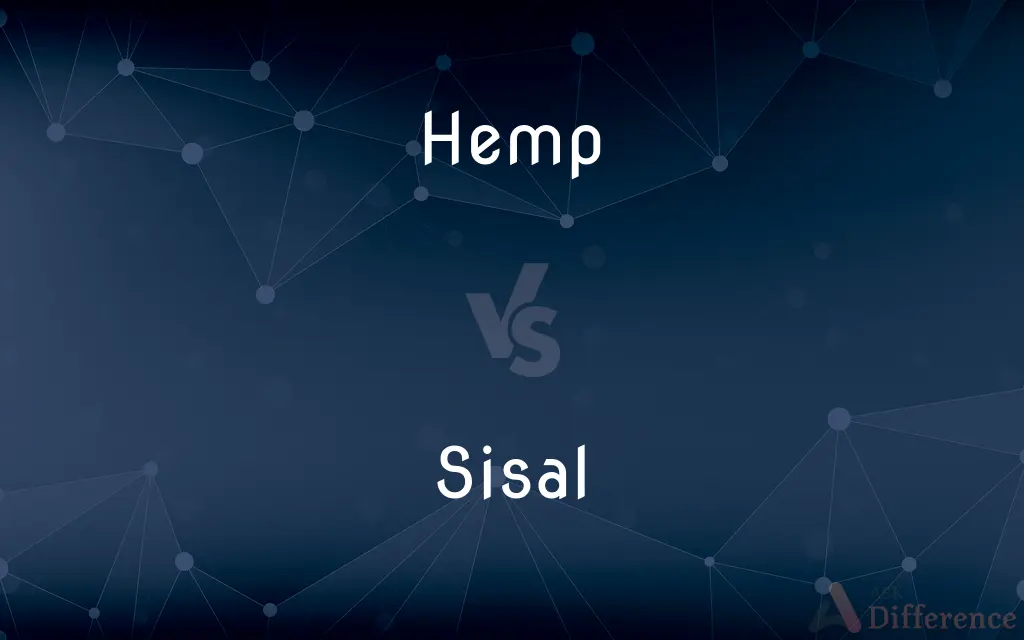Hemp vs. Sisal — What's the Difference?
By Tayyaba Rehman & Fiza Rafique — Updated on March 30, 2024
Hemp is versatile fiber derived from the Cannabis sativa plant, known for its strength and used in textiles, ropes, and sustainable materials, while sisal is notable for its rigidity and use in twine, rugs, and biodegradable products.

Difference Between Hemp and Sisal
Table of Contents
ADVERTISEMENT
Key Differences
Hemp fibers are extracted from the stalks of the Cannabis sativa plant, offering exceptional tensile strength, durability, and mildew resistance, making them ideal for a wide range of applications from clothing to bioplastics. In contrast, sisal fibers come from the leaves of the Agave sisalana plant, characterized by their stiffness, durability, and resistance to deterioration in saltwater, predominantly used in agricultural twine, rugs, and various handicrafts.
Environmentally, hemp stands out for its rapid growth and ability to improve soil health, requiring minimal pesticides and water compared to conventional crops. Sisal, similarly eco-friendly, thrives in arid environments, contributing to soil conservation and requiring minimal chemical treatments, making both fibers sustainable choices for eco-conscious consumers.
In the textile industry, hemp is praised for its breathability, insulation properties, and softness over time with washing, making it a preferred material for clothing and luxury textiles. Sisal's coarse texture limits its use in soft goods, favoring its application in durable floor coverings, rope, and wall coverings.
Both hemp and sisal have seen innovation in their use, extending into the automotive industry for interior coverings and composite materials, highlighting their versatility. Despite these innovations, hemp's broader application range, including its use in paper, construction materials, and as a CBD source, contrasts with sisal's focused use in cordage and durable goods.
The cultivation and processing differences between hemp and sisal reflect their distinct botanical origins and end uses. Hemp processing involves retting and softening the fibers, while sisal processing requires crushing and washing the leaves to extract the fibers, showcasing each plant's unique properties and contributions to sustainable materials.
ADVERTISEMENT
Comparison Chart
Source Plant
Cannabis sativa
Agave sisalana
Environmental Impact
Low water and pesticide use, improves soil
Thrives in arid conditions, minimal chemicals
Main Uses
Textiles, ropes, bioplastics
Twine, rugs, handicrafts
Texture
Softens with washing, versatile
Coarse, rigid
Durability
High tensile strength, durable
High durability, resistant to saltwater
Sustainability
Rapid growth, enhances soil
Requires minimal irrigation, eco-friendly
Innovation
Used in automotive, construction, CBD oil
Used in biodegradable composites, handicrafts
Compare with Definitions
Hemp
Ingredient in bioplastics and construction materials.
Hemp is used to create lightweight, sustainable building materials.
Sisal
A stiff fiber from the Agave sisalana plant.
Sisal twine is widely used in agriculture for its strength and rigidity.
Hemp
A strong, durable fiber from the Cannabis sativa plant.
Hemp ropes are valued for their strength and durability.
Sisal
Used in wall coverings and handicrafts for its texture.
Sisal wall coverings add a rustic texture to interiors.
Hemp
Grows rapidly with minimal environmental impact.
Hemp cultivation is noted for its soil-improving qualities.
Sisal
Predominantly used in durable goods like rugs.
Sisal rugs are appreciated for their natural look and durability.
Hemp
Source of CBD oil with various applications.
CBD oil, extracted from hemp, is used in wellness and medical products.
Sisal
Eco-friendly, requiring little water or chemicals.
Sisal cultivation is ideal for arid regions, contributing to sustainability.
Hemp
Used in sustainable textiles and clothing.
Hemp fabric is becoming popular in eco-friendly fashion.
Sisal
Integrated into biodegradable products and composites.
Sisal is explored for use in biodegradable composite materials.
Hemp
Hemp, or industrial hemp, is a variety of the Cannabis sativa plant species that is grown specifically for industrial use. It can be used to make a wide range of products.
Sisal
Sisal (, Spanish: [siˈsal]), with the botanical name Agave sisalana, is a species of flowering plant native to southern Mexico but widely cultivated and naturalized in many other countries. It yields a stiff fibre used in making rope and various other products.
Hemp
The cannabis plant, especially when grown for fibre.
Sisal
A cultivated agave (Agave sisalana) originally of Mexico and Central America, widely grown for its large, sword-shaped leaves that yield stiff fibers used for cordage and rope.
Hemp
Cannabis.
Sisal
The fiber of this plant or of other agaves.
Hemp
The tough, coarse fiber of the cannabis plant, used to make cordage, yarn, and fabric.
Sisal
A Central American plant, Agave sisalana, cultivated for its sword-shaped leaves that yield fibers used for rope.
Hemp
Any of various plants similar to cannabis, especially one yielding a similar fiber.
Sisal
The fibre of the plant.
Hemp
The fiber of such a plant.
Sisal
(rare) A sisal mat.
Hemp
A tall annual herb, Cannabis sativa, native to Asia.
Sisal
A plant fiber used for making rope
Hemp
Various products of this plant, including fibres and the drug cannabis.
Sisal
Mexican or West Indian plant with large fleshy leaves yielding a stiff fiber used in e.g. rope
Hemp
The gallows.
Hemp
A plant of the genus Cannabis (Cannabis sativa), the fibrous skin or bark of which is used for making cloth and cordage. The name is also applied to various other plants yielding fiber.
Hemp
The fiber of the skin or rind of the plant, prepared for spinning. The name has also been extended to various fibers resembling the true hemp.
Hemp
A plant fiber
Hemp
Any plant of the genus Cannabis; a coarse bushy annual with palmate leaves and clusters of small green flowers; yields tough fibers and narcotic drugs
Hemp
A rope that is used by a hangman to execute persons who have been condemned to death by hanging
Common Curiosities
What are the key differences in processing hemp and sisal?
Hemp processing involves retting to separate fibers, whereas sisal requires crushing and washing leaves to extract fibers.
Can both hemp and sisal be used in the automotive industry?
Yes, both fibers are used in automotive interiors and composite materials for their strength and sustainability.
How do hemp and sisal contribute to sustainable agriculture?
Both crops require minimal chemicals and are grown in conditions that contribute to soil conservation and biodiversity.
Can sisal be used in clothing?
Due to its coarse texture, sisal is not typically used in clothing but excels in durable items like rugs and twine.
What innovations are being made with sisal?
Innovations include its use in biodegradable composites and as a sustainable alternative in various industries.
How do hemp and sisal compare in terms of water usage?
Hemp requires relatively low water compared to traditional crops, while sisal is adapted to arid conditions, needing even less.
Why is sisal preferred for marine applications?
Sisal's resistance to saltwater deterioration makes it ideal for marine ropes and other applications.
Why is hemp considered environmentally friendly?
Hemp is low in water and pesticide needs, improves soil health, and sequesters carbon, making it environmentally beneficial.
How has hemp's legal status affected its use?
Regulations around cannabis have historically limited hemp's use, but recent legalizations have expanded its applications.
What are the future prospects for hemp and sisal in sustainability?
As demand for sustainable materials grows, both hemp and sisal are poised for increased use in eco-friendly products and practices.
What makes hemp a versatile material?
Hemp's strong fibers, environmental benefits, and wide range of applications, from textiles to bioplastics, make it versatile.
What challenges face the sisal industry?
Challenges include competition with synthetic fibers and the need for innovation to expand its use beyond traditional products.
Is sisal biodegradable?
Yes, sisal is biodegradable, making it an environmentally friendly option for products requiring durability and natural decomposition.
How do the environmental impacts of growing hemp and sisal compare?
Both have positive environmental impacts, with hemp improving soil health and sisal thriving with minimal water and no pesticides, both contributing to sustainable practices.
How does the texture of hemp fabric change with use?
Hemp fabric becomes softer and more comfortable with each wash, enhancing its appeal for clothing and textiles.
Share Your Discovery

Previous Comparison
Hardware vs. Ironmongery
Next Comparison
Link vs. NexusAuthor Spotlight
Written by
Tayyaba RehmanTayyaba Rehman is a distinguished writer, currently serving as a primary contributor to askdifference.com. As a researcher in semantics and etymology, Tayyaba's passion for the complexity of languages and their distinctions has found a perfect home on the platform. Tayyaba delves into the intricacies of language, distinguishing between commonly confused words and phrases, thereby providing clarity for readers worldwide.
Co-written by
Fiza RafiqueFiza Rafique is a skilled content writer at AskDifference.com, where she meticulously refines and enhances written pieces. Drawing from her vast editorial expertise, Fiza ensures clarity, accuracy, and precision in every article. Passionate about language, she continually seeks to elevate the quality of content for readers worldwide.















































